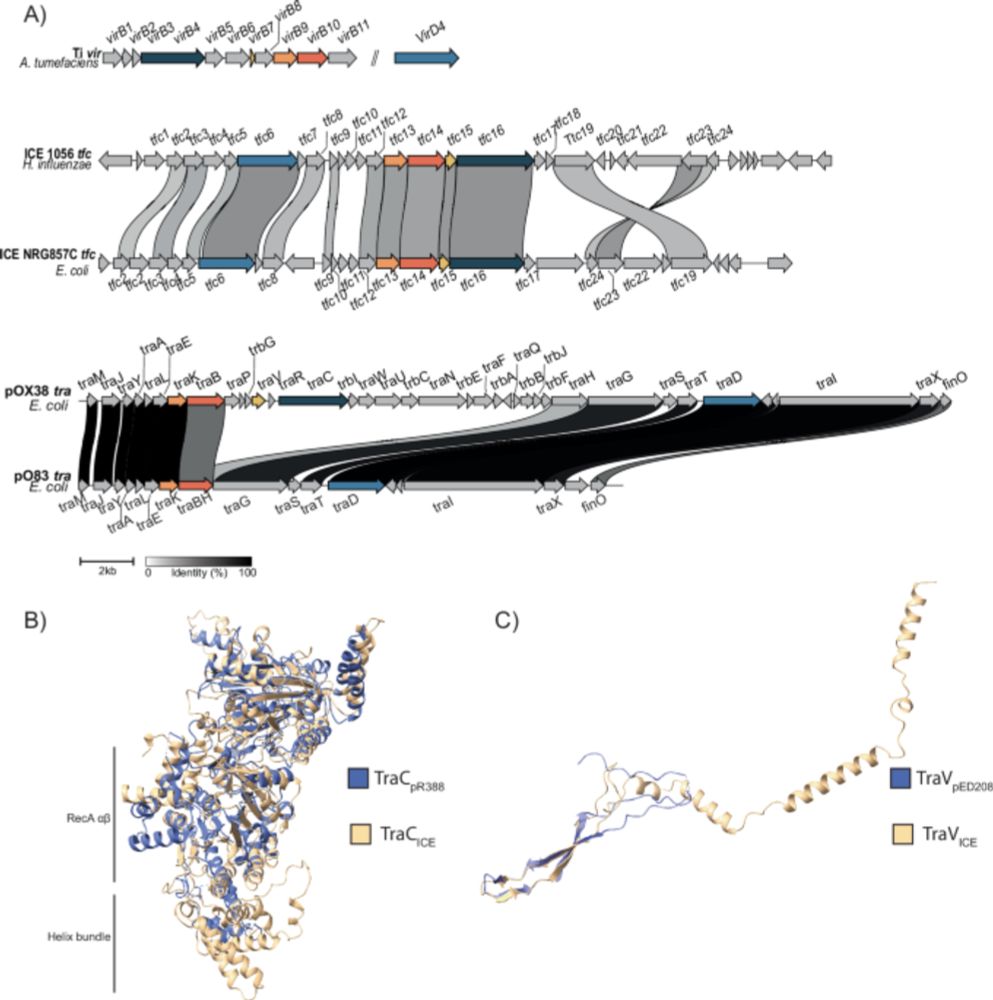Carlos Serna
@cserna.bsky.social
Graduate Teaching Assistant at UCM (Madrid). Interested on epidemiology, bacterial genomics, bioinformatics and AMR 🧬💻🐄
Pinned
Carlos Serna
@cserna.bsky.social
· Jul 17
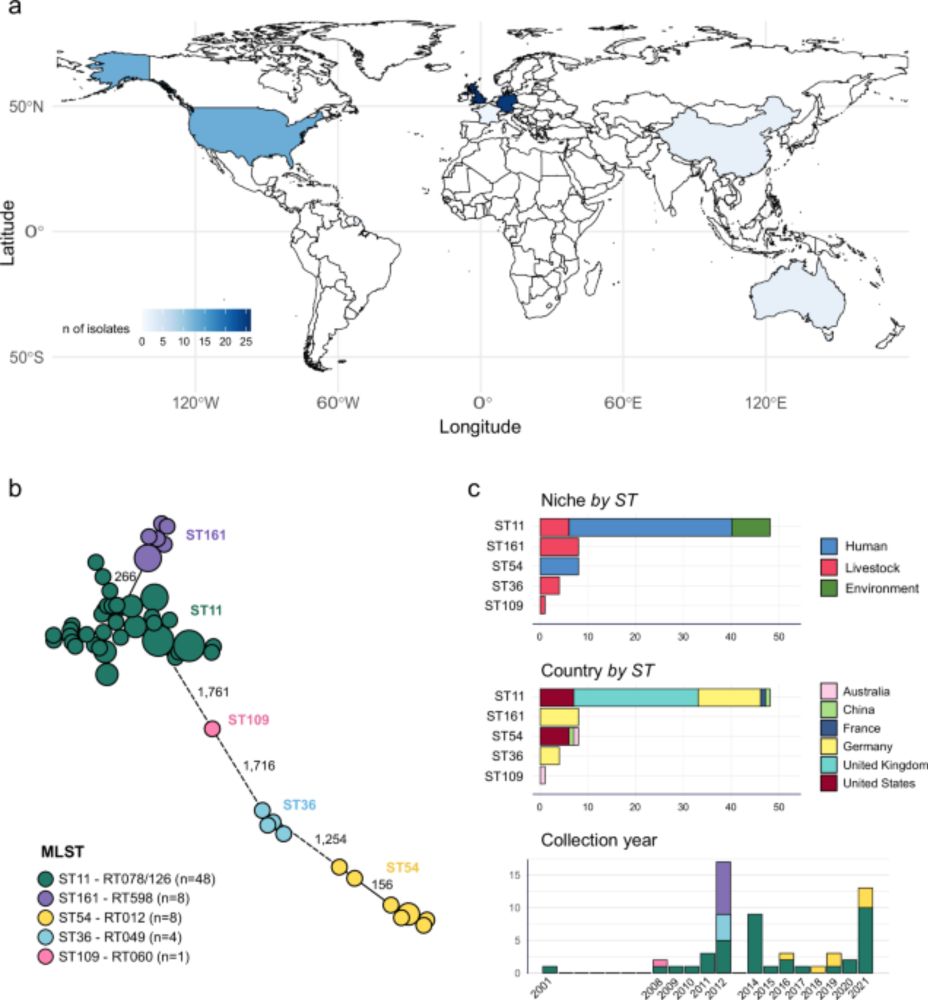
Global dissemination of npmA mediated pan-aminoglycoside resistance via a mobile genetic element in Gram-positive bacteria - Nature Communications
The authors investigate the distribution of the aminoglycoside resistance gene npmA in Gram-positive bacteria via a mobile genetic element, highlighting its global presence and cross-species transfer ...
www.doi.org
Our paper “Global dissemination of npmA mediated pan‑aminoglycoside resistance via a mobile element in Gram‑positive bacteria” is now in @natcomms.nature.com. Part of my freshly defended PhD, so doubly happy! 😄🎉
🧵 (1/14)
www.doi.org/10.1038/s414...
🧵 (1/14)
www.doi.org/10.1038/s414...
Reposted by Carlos Serna
🚨 Excited to share our new paper is out! 🎉
We show how interactions within gut microbiomes allow certain antibiotic-resistant E. coli strains to persist even without antibiotics, helping explain how resistance is maintained in the human gut.
Now published in @natcomms.nature.com rdcu.be/eOf63
We show how interactions within gut microbiomes allow certain antibiotic-resistant E. coli strains to persist even without antibiotics, helping explain how resistance is maintained in the human gut.
Now published in @natcomms.nature.com rdcu.be/eOf63

Multi-layered ecological interactions determine growth of clinical antibiotic-resistant strains within human microbiomes
Nature Communications - The role of ecological factors in modulating the spread of antibiotic-resistance bacteria in the gut remains unclear. Here, the authors use anaerobic microcosms to study the...
rdcu.be
November 7, 2025 at 9:15 AM
🚨 Excited to share our new paper is out! 🎉
We show how interactions within gut microbiomes allow certain antibiotic-resistant E. coli strains to persist even without antibiotics, helping explain how resistance is maintained in the human gut.
Now published in @natcomms.nature.com rdcu.be/eOf63
We show how interactions within gut microbiomes allow certain antibiotic-resistant E. coli strains to persist even without antibiotics, helping explain how resistance is maintained in the human gut.
Now published in @natcomms.nature.com rdcu.be/eOf63
Reposted by Carlos Serna
New(ish!) paper on how within-host competition and antibiotic resistance shape the fitness of Streptococcus pneumoniae serotypes, out in August in Plos Biology. journals.plos.org/plosbiology/...

Quantifying the effects of antibiotic resistance and within-host competition on strain fitness in Streptococcus pneumoniae
Competition significantly influences bacterial population dynamics, particularly in how strains interact within and between hosts. This study shows that within-host competition in Streptococcus pneumo...
journals.plos.org
October 31, 2025 at 3:05 PM
New(ish!) paper on how within-host competition and antibiotic resistance shape the fitness of Streptococcus pneumoniae serotypes, out in August in Plos Biology. journals.plos.org/plosbiology/...
Reposted by Carlos Serna
Delighted to have played a small part in this great study from colleagues in CaPES: doi.org/10.1038/s414...

Plasmid dynamics driving carbapenemase gene dissemination in healthcare environments: a nationwide analysis of closed Enterobacterales genomes - Nature Communications
Plasmid-mediated transmission plays a significant role in the spread of carbapenem-resistant Enterobacterales. Here, analyzing 1,115 carbapenemase-producing plasmids from Singapore, the authors sugges...
doi.org
October 29, 2025 at 9:57 AM
Delighted to have played a small part in this great study from colleagues in CaPES: doi.org/10.1038/s414...
Reposted by Carlos Serna
Interesting paper
'Antimicrobial resistance among Gram-positive agents of bacteraemia in the UK and Ireland: trends from 2001 to 2019'
TL;DR:
- dramatic falls in MRSA
- pneumococcal resistance rates low
- E. faecium more prevalent (and more vanR) than E. faecalis
pubmed.ncbi.nlm.nih.gov/41140273/
'Antimicrobial resistance among Gram-positive agents of bacteraemia in the UK and Ireland: trends from 2001 to 2019'
TL;DR:
- dramatic falls in MRSA
- pneumococcal resistance rates low
- E. faecium more prevalent (and more vanR) than E. faecalis
pubmed.ncbi.nlm.nih.gov/41140273/

Antimicrobial resistance among Gram-positive agents of bacteraemia in the UK and Ireland: trends from 2001 to 2019 - PubMed
Gram-positive pathogens were the dominant historical pathogens of bacteraemia. The trends seen here-with many near-universally active antibiotics-indicate little hazard of this situation returning. Nevertheless, few treatments exist in some settings, notably multi-resistant E. faecium endocarditis.
pubmed.ncbi.nlm.nih.gov
October 28, 2025 at 10:17 AM
Interesting paper
'Antimicrobial resistance among Gram-positive agents of bacteraemia in the UK and Ireland: trends from 2001 to 2019'
TL;DR:
- dramatic falls in MRSA
- pneumococcal resistance rates low
- E. faecium more prevalent (and more vanR) than E. faecalis
pubmed.ncbi.nlm.nih.gov/41140273/
'Antimicrobial resistance among Gram-positive agents of bacteraemia in the UK and Ireland: trends from 2001 to 2019'
TL;DR:
- dramatic falls in MRSA
- pneumococcal resistance rates low
- E. faecium more prevalent (and more vanR) than E. faecalis
pubmed.ncbi.nlm.nih.gov/41140273/
Reposted by Carlos Serna
New paper with my (amazing) friend and mentor @jrpenades.bsky.social
Really looking forward to see what plasmid aficionados think of this one!!
With @asantoslopez.bsky.social @wfigueroac3.bsky.social Akshay Sabins and others
www.cell.com/cell-reports...
Really looking forward to see what plasmid aficionados think of this one!!
With @asantoslopez.bsky.social @wfigueroac3.bsky.social Akshay Sabins and others
www.cell.com/cell-reports...

Non-conjugative plasmids limit their mobility to persist in nature
Sabnis et al. explain why non-conjugative plasmids move at a low rate in nature. While
increased mobility can easily evolve by incorporating phage DNA into plasmids, this
is disadvantageous because it...
www.cell.com
October 22, 2025 at 1:12 PM
New paper with my (amazing) friend and mentor @jrpenades.bsky.social
Really looking forward to see what plasmid aficionados think of this one!!
With @asantoslopez.bsky.social @wfigueroac3.bsky.social Akshay Sabins and others
www.cell.com/cell-reports...
Really looking forward to see what plasmid aficionados think of this one!!
With @asantoslopez.bsky.social @wfigueroac3.bsky.social Akshay Sabins and others
www.cell.com/cell-reports...
Reposted by Carlos Serna
🧬 New #GenEpiBioTrain course!
Bacterial Strain Taxonomy for Genomic Surveillance
📅 22–23.10, 09:00–12:00 (CEST)
Learn how bacterial pathogens are classified & named in genomic surveillance – from #MLST & #cgMLST to SNP-based & k-mer clustering.
Info: bit.ly/48qT5df
#ECDCTraining #IDsky #EpiSky
Bacterial Strain Taxonomy for Genomic Surveillance
📅 22–23.10, 09:00–12:00 (CEST)
Learn how bacterial pathogens are classified & named in genomic surveillance – from #MLST & #cgMLST to SNP-based & k-mer clustering.
Info: bit.ly/48qT5df
#ECDCTraining #IDsky #EpiSky

October 8, 2025 at 2:34 PM
🧬 New #GenEpiBioTrain course!
Bacterial Strain Taxonomy for Genomic Surveillance
📅 22–23.10, 09:00–12:00 (CEST)
Learn how bacterial pathogens are classified & named in genomic surveillance – from #MLST & #cgMLST to SNP-based & k-mer clustering.
Info: bit.ly/48qT5df
#ECDCTraining #IDsky #EpiSky
Bacterial Strain Taxonomy for Genomic Surveillance
📅 22–23.10, 09:00–12:00 (CEST)
Learn how bacterial pathogens are classified & named in genomic surveillance – from #MLST & #cgMLST to SNP-based & k-mer clustering.
Info: bit.ly/48qT5df
#ECDCTraining #IDsky #EpiSky
Reposted by Carlos Serna
Imagine we could travel back in time ⏪⌛️to explore the world of bacterial pathogens before humans discovered and industrialised antibiotics
We just did that to study the history of #AMR spread @science.org
doi.org/10.1126/scie...
If you like time travel & biology, this 🧵is for you👇
We just did that to study the history of #AMR spread @science.org
doi.org/10.1126/scie...
If you like time travel & biology, this 🧵is for you👇

Pre- and postantibiotic epoch: The historical spread of antimicrobial resistance
Plasmids are now the primary vectors of antimicrobial resistance, but our understanding of how human industrialisation of antibiotics influenced their evolution is limited by a paucity of data predati...
doi.org
October 6, 2025 at 10:42 AM
Imagine we could travel back in time ⏪⌛️to explore the world of bacterial pathogens before humans discovered and industrialised antibiotics
We just did that to study the history of #AMR spread @science.org
doi.org/10.1126/scie...
If you like time travel & biology, this 🧵is for you👇
We just did that to study the history of #AMR spread @science.org
doi.org/10.1126/scie...
If you like time travel & biology, this 🧵is for you👇
Reposted by Carlos Serna
Dear community, Bakta needs your help!
To further improve the functional annotation of "hypothetical" CDS, me and @gbouras13.bsky.social, we are looking for the worst Bakta-annotated bacterial genomes ;-)
(1/2)
To further improve the functional annotation of "hypothetical" CDS, me and @gbouras13.bsky.social, we are looking for the worst Bakta-annotated bacterial genomes ;-)
(1/2)
October 6, 2025 at 7:27 AM
Dear community, Bakta needs your help!
To further improve the functional annotation of "hypothetical" CDS, me and @gbouras13.bsky.social, we are looking for the worst Bakta-annotated bacterial genomes ;-)
(1/2)
To further improve the functional annotation of "hypothetical" CDS, me and @gbouras13.bsky.social, we are looking for the worst Bakta-annotated bacterial genomes ;-)
(1/2)
Reposted by Carlos Serna
Reposted by Carlos Serna
Now published, our tool to run (almost) all biological models interactively in your web browser
Paper: academic.oup.com/bioinformati...
Website: biomodels.bacpop.org
Code: github.com/bacpop/SBMLt...
Paper: academic.oup.com/bioinformati...
Website: biomodels.bacpop.org
Code: github.com/bacpop/SBMLt...
September 29, 2025 at 9:49 AM
Now published, our tool to run (almost) all biological models interactively in your web browser
Paper: academic.oup.com/bioinformati...
Website: biomodels.bacpop.org
Code: github.com/bacpop/SBMLt...
Paper: academic.oup.com/bioinformati...
Website: biomodels.bacpop.org
Code: github.com/bacpop/SBMLt...
Reposted by Carlos Serna
To summarise our recent pre-print: Autocycler, the automated consensus assembler, when used with Nanopore long-read only Enterobacterales assemblies, produces more complete chromosomes and plasmids, with an accuracy comparable to hybrid assemblies.

September 29, 2025 at 6:57 AM
To summarise our recent pre-print: Autocycler, the automated consensus assembler, when used with Nanopore long-read only Enterobacterales assemblies, produces more complete chromosomes and plasmids, with an accuracy comparable to hybrid assemblies.
Reposted by Carlos Serna
Interesting benchmark paper from @dotnagy.bsky.social
"Autocycler circularised the most chromosomes (87/92). .. Flye performed worse than other assemblers on almost all metrics. Autocycler + Medaka... was the most accurate long-read only assembler/polisher "
www.biorxiv.org/content/10.1...
"Autocycler circularised the most chromosomes (87/92). .. Flye performed worse than other assemblers on almost all metrics. Autocycler + Medaka... was the most accurate long-read only assembler/polisher "
www.biorxiv.org/content/10.1...

Nanopore long-read only genome assembly of clinical Enterobacterales isolates is complete and accurate
Whole bacterial genome sequence reconstruction using Oxford Nanopore Technologies (“Nanopore”) long-read only sequencing may offer a lower-cost, higher-throughput alternative for pathogen surveillance...
www.biorxiv.org
September 26, 2025 at 8:40 PM
Interesting benchmark paper from @dotnagy.bsky.social
"Autocycler circularised the most chromosomes (87/92). .. Flye performed worse than other assemblers on almost all metrics. Autocycler + Medaka... was the most accurate long-read only assembler/polisher "
www.biorxiv.org/content/10.1...
"Autocycler circularised the most chromosomes (87/92). .. Flye performed worse than other assemblers on almost all metrics. Autocycler + Medaka... was the most accurate long-read only assembler/polisher "
www.biorxiv.org/content/10.1...
Reposted by Carlos Serna
Delighted to see our paper studying the evolution of plasmids over the last 100 years, now out! Years of work by Adrian Cazares, also Nick Thomson @sangerinstitute.bsky.social - this version much improved over the preprint. Final version should be open access, apols.
Thread 1/n
Thread 1/n

September 25, 2025 at 9:29 PM
Delighted to see our paper studying the evolution of plasmids over the last 100 years, now out! Years of work by Adrian Cazares, also Nick Thomson @sangerinstitute.bsky.social - this version much improved over the preprint. Final version should be open access, apols.
Thread 1/n
Thread 1/n
Reposted by Carlos Serna
The EMBL PhD programme is open until 13th October (entry ~Sep 2026):
www.embl.org/about/info/e...
We have three positions in microbial genomics at EMBL-EBI, including one in my group. Please do apply, or if you know anyone that would be interested pass on to them
www.embl.org/about/info/e...
We have three positions in microbial genomics at EMBL-EBI, including one in my group. Please do apply, or if you know anyone that would be interested pass on to them
EMBL International PhD Programme – Unique in the world and waiting for you!
www.embl.org
September 17, 2025 at 3:49 PM
The EMBL PhD programme is open until 13th October (entry ~Sep 2026):
www.embl.org/about/info/e...
We have three positions in microbial genomics at EMBL-EBI, including one in my group. Please do apply, or if you know anyone that would be interested pass on to them
www.embl.org/about/info/e...
We have three positions in microbial genomics at EMBL-EBI, including one in my group. Please do apply, or if you know anyone that would be interested pass on to them
Reposted by Carlos Serna
Thanks for all the trainers and attendees on this course, which was a lot of fun to run, and hopefully filled a gap in genomics/modelling training
And especially co-organisers @leonielorenz.bsky.social @sonjalehtinen.bsky.social Joel Hellewell
And especially co-organisers @leonielorenz.bsky.social @sonjalehtinen.bsky.social Joel Hellewell
Thank you to everyone who joined us this week for the @embo.org Practical Course 'Methods for infectious disease modelling using genomics'.
Join us for 2026's EMBO Practical Course. Sign up for 'Causality in biomedicine' alerts and hear as this new course develops: www.ebi.ac.uk/training/eve...
🧬🧫
Join us for 2026's EMBO Practical Course. Sign up for 'Causality in biomedicine' alerts and hear as this new course develops: www.ebi.ac.uk/training/eve...
🧬🧫

September 22, 2025 at 9:43 AM
Thanks for all the trainers and attendees on this course, which was a lot of fun to run, and hopefully filled a gap in genomics/modelling training
And especially co-organisers @leonielorenz.bsky.social @sonjalehtinen.bsky.social Joel Hellewell
And especially co-organisers @leonielorenz.bsky.social @sonjalehtinen.bsky.social Joel Hellewell
Reposted by Carlos Serna
Open PhD position in our lab for starting roughly in September 2026. Cannot recommend this lab enough!!! 🦠🖥️
#MathematicalModelling
#BacterialGenomics
#Bioinformatics
#MathematicalModelling
#BacterialGenomics
#Bioinformatics
The EMBL PhD programme is open until 13th October (entry ~Sep 2026):
www.embl.org/about/info/e...
We have three positions in microbial genomics at EMBL-EBI, including one in my group. Please do apply, or if you know anyone that would be interested pass on to them
www.embl.org/about/info/e...
We have three positions in microbial genomics at EMBL-EBI, including one in my group. Please do apply, or if you know anyone that would be interested pass on to them
EMBL International PhD Programme – Unique in the world and waiting for you!
www.embl.org
September 19, 2025 at 1:37 PM
Open PhD position in our lab for starting roughly in September 2026. Cannot recommend this lab enough!!! 🦠🖥️
#MathematicalModelling
#BacterialGenomics
#Bioinformatics
#MathematicalModelling
#BacterialGenomics
#Bioinformatics
Reposted by Carlos Serna
A little tool I've developed: ExpEvoAnalyzer (github.com/samhorsfield...) - a snakemake pipeline that compares isolate paired-read data from an experimental evolution study to a reference isolate, producing functionally-annotated SNPs in a presence/absence matrix.
GitHub - samhorsfield96/ExpEvoAnalyzer: A workflow to analyse experimental evolution data.
A workflow to analyse experimental evolution data. - samhorsfield96/ExpEvoAnalyzer
github.com
September 11, 2025 at 2:16 PM
A little tool I've developed: ExpEvoAnalyzer (github.com/samhorsfield...) - a snakemake pipeline that compares isolate paired-read data from an experimental evolution study to a reference isolate, producing functionally-annotated SNPs in a presence/absence matrix.
Reposted by Carlos Serna
For anyone who has used pling for comparing plasmids using rearrangement distances ("how many structural events apart are these plasmids"), here's how to tweak parameters, and integrate it with typing info, and the host phylogeny
www.biorxiv.org/content/10.1...
github.com/iqbal-lab-or...
www.biorxiv.org/content/10.1...
github.com/iqbal-lab-or...

Clustering of plasmid genomes for genomic epidemiology by using rearrangement distances, with pling
Integration of plasmids into genomic epidemiology is challenging, because there are no clearly defined evolving-units (equivalent to species), and because plasmids appear to evolve as much by structur...
www.biorxiv.org
September 7, 2025 at 2:56 PM
For anyone who has used pling for comparing plasmids using rearrangement distances ("how many structural events apart are these plasmids"), here's how to tweak parameters, and integrate it with typing info, and the host phylogeny
www.biorxiv.org/content/10.1...
github.com/iqbal-lab-or...
www.biorxiv.org/content/10.1...
github.com/iqbal-lab-or...
Reposted by Carlos Serna
What was antibiotic resistance like before we ever used antibiotics? How did we change what antibiotic resistance genes looked like over 100 years?
Our paper looking at resistance genes from a century of NCTC historical isolates now out in mGen:
www.microbiologyresearch.org/content/jour...
Our paper looking at resistance genes from a century of NCTC historical isolates now out in mGen:
www.microbiologyresearch.org/content/jour...

Genomic resistance in historical clinical isolates increased in frequency and mobility after the age of antibiotics
Antibiotic resistance is frequently observed shortly after the clinical introduction of an antibiotic. Whether and how frequently that resistance occurred before the introduction is harder to determin...
www.microbiologyresearch.org
September 1, 2025 at 5:49 PM
What was antibiotic resistance like before we ever used antibiotics? How did we change what antibiotic resistance genes looked like over 100 years?
Our paper looking at resistance genes from a century of NCTC historical isolates now out in mGen:
www.microbiologyresearch.org/content/jour...
Our paper looking at resistance genes from a century of NCTC historical isolates now out in mGen:
www.microbiologyresearch.org/content/jour...
Reposted by Carlos Serna
This work is finally published! 🥳🧬
Plasmids are associated with very variable fitness costs in their different bacterial hosts. But, what is the contribution of each of the plasmid-genes in these host-specific effects? Study led by
@jorgesastred.bsky.social, @sanmillan.bsky.social and myself! 1/14
Plasmids are associated with very variable fitness costs in their different bacterial hosts. But, what is the contribution of each of the plasmid-genes in these host-specific effects? Study led by
@jorgesastred.bsky.social, @sanmillan.bsky.social and myself! 1/14
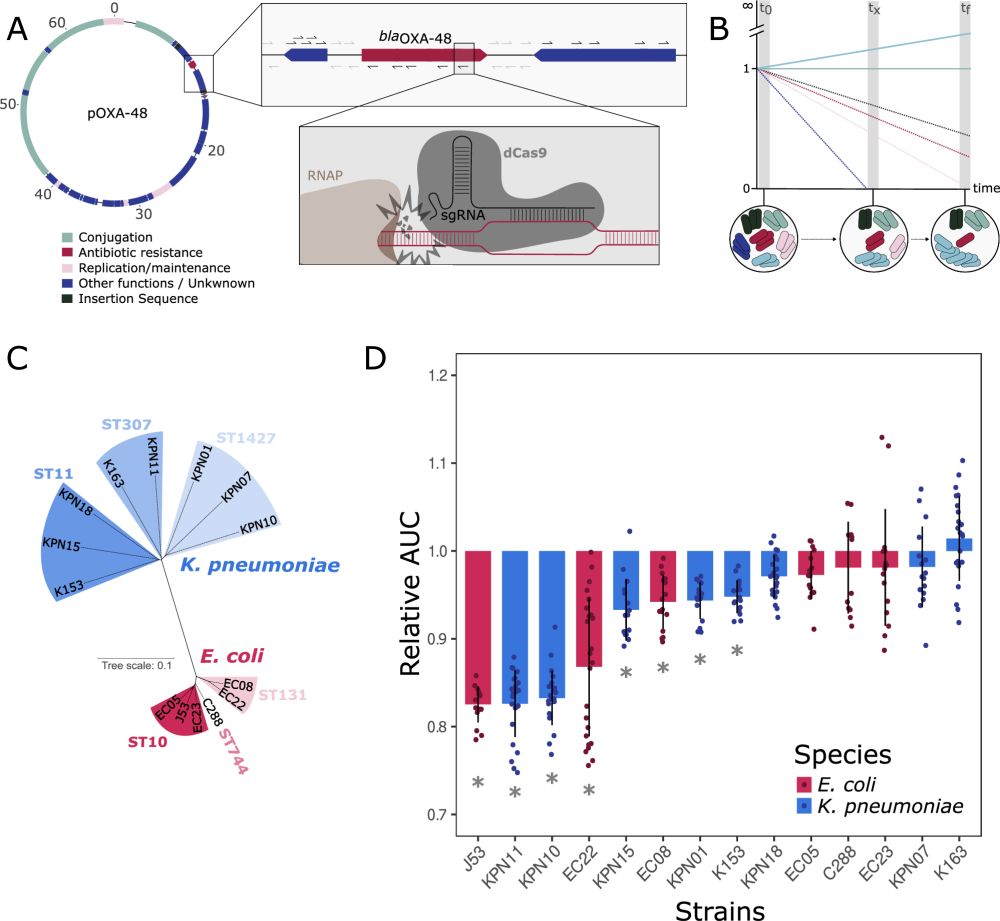
Dissecting pOXA-48 fitness effects in clinical Enterobacterales using plasmid-wide CRISPRi screens
Nature Communications - This study investigates the effects of the carbapenem resistance plasmid pOXA-48 in clinical enterobacteria. Using CRISPRi screens, the authors revealed that the...
rdcu.be
August 20, 2025 at 1:25 PM
This work is finally published! 🥳🧬
Plasmids are associated with very variable fitness costs in their different bacterial hosts. But, what is the contribution of each of the plasmid-genes in these host-specific effects? Study led by
@jorgesastred.bsky.social, @sanmillan.bsky.social and myself! 1/14
Plasmids are associated with very variable fitness costs in their different bacterial hosts. But, what is the contribution of each of the plasmid-genes in these host-specific effects? Study led by
@jorgesastred.bsky.social, @sanmillan.bsky.social and myself! 1/14
Reposted by Carlos Serna
If you ever find yourself needing evidence for ‘Plasmids are just as common in microbes without resistance genes,’ we’ve got you covered! Check our new paper, out today:
www.microbiologyresearch.org/content/jour...
www.microbiologyresearch.org/content/jour...

Plasmid prevalence is independent of antibiotic resistance in environmental Enterobacteriaceae
The rapid rise of antibiotic-resistant pathogens poses a critical threat to the treatment of infectious diseases. While the spread of antibiotic resistance genes (ARGs) via plasmid conjugation has bee...
www.microbiologyresearch.org
August 12, 2025 at 5:14 PM
If you ever find yourself needing evidence for ‘Plasmids are just as common in microbes without resistance genes,’ we’ve got you covered! Check our new paper, out today:
www.microbiologyresearch.org/content/jour...
www.microbiologyresearch.org/content/jour...
Reposted by Carlos Serna
Oxygen levels can affect how resistance genes work, impacting antibiotic efficacy. This can be relevant for the most used ones: for example, resistance to fosfomycin varies with oxygen.
Learn more in our latest paper 👉 bit.ly/3T8sdpp a work led by @jaescudero.bsky.social
#AntibioticResistance
Learn more in our latest paper 👉 bit.ly/3T8sdpp a work led by @jaescudero.bsky.social
#AntibioticResistance
August 4, 2025 at 8:52 AM
Oxygen levels can affect how resistance genes work, impacting antibiotic efficacy. This can be relevant for the most used ones: for example, resistance to fosfomycin varies with oxygen.
Learn more in our latest paper 👉 bit.ly/3T8sdpp a work led by @jaescudero.bsky.social
#AntibioticResistance
Learn more in our latest paper 👉 bit.ly/3T8sdpp a work led by @jaescudero.bsky.social
#AntibioticResistance
Reposted by Carlos Serna
#NewResearch
'The food-associated resistome is shaped by processing and production environments' by @nmquijada.bsky.social and co-workers.
#MicroSky 🦠
www.nature.com/articles/s41...
'The food-associated resistome is shaped by processing and production environments' by @nmquijada.bsky.social and co-workers.
#MicroSky 🦠
www.nature.com/articles/s41...
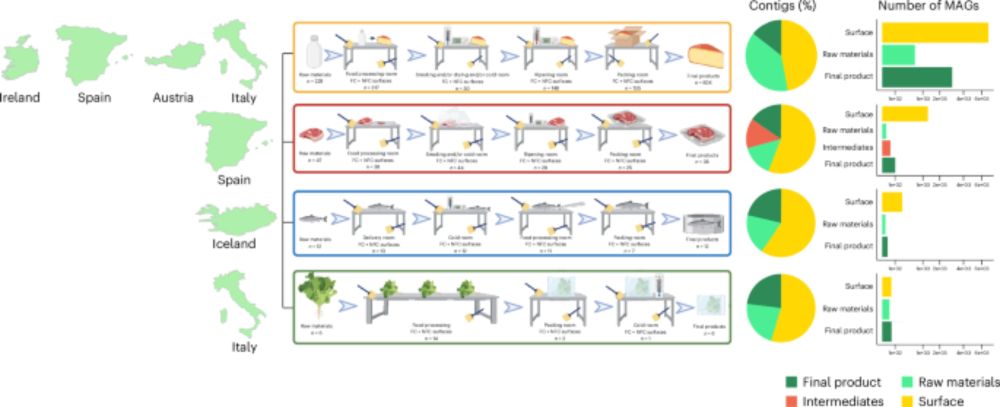
The food-associated resistome is shaped by processing and production environments - Nature Microbiology
Whole-metagenome sequencing of 1,780 raw-material, end-product and surface samples from 113 food processing facilities reveals the occurrence of antimicrobial resistance determinants in foods and thei...
www.nature.com
July 30, 2025 at 3:22 PM
#NewResearch
'The food-associated resistome is shaped by processing and production environments' by @nmquijada.bsky.social and co-workers.
#MicroSky 🦠
www.nature.com/articles/s41...
'The food-associated resistome is shaped by processing and production environments' by @nmquijada.bsky.social and co-workers.
#MicroSky 🦠
www.nature.com/articles/s41...
Reposted by Carlos Serna
Pleased to say that our preprint benchmarking Nanopore data for MLST, cgMLST, cgSNP & AMR typing from bacterial isolates is out! TL;DR you can get almost perfect results from 50x depth using live SUP basecalling with a GPU in under 20 hours #microsky#IDsky 🦠🧬🖥️ /1
www.medrxiv.org/content/10.1...
www.medrxiv.org/content/10.1...
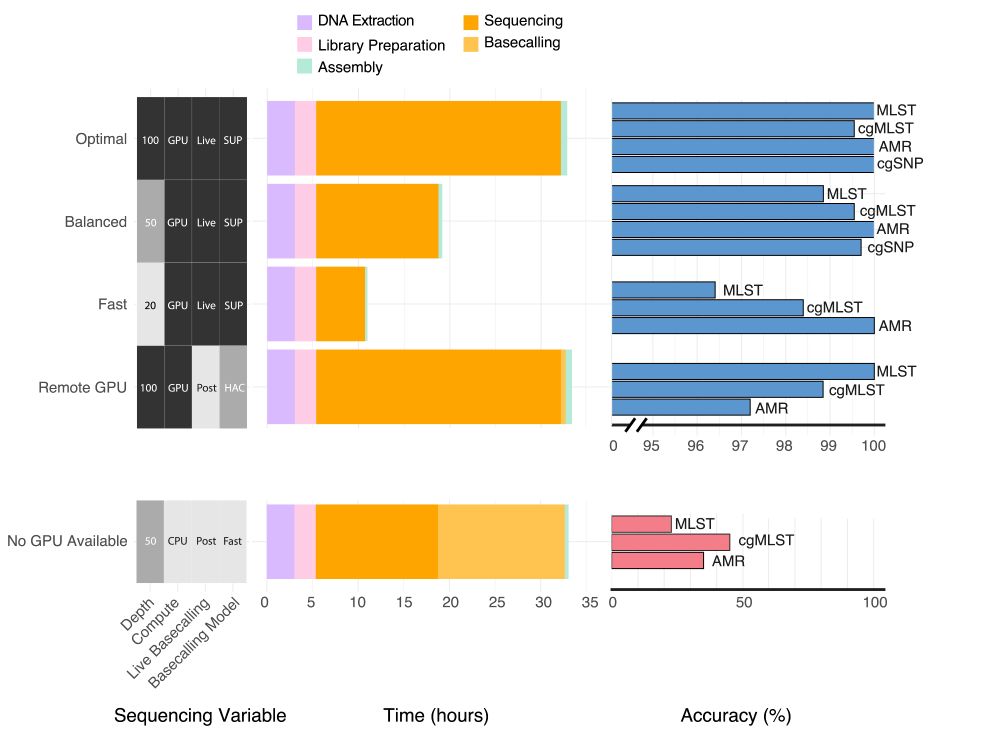
July 30, 2025 at 2:11 AM
Pleased to say that our preprint benchmarking Nanopore data for MLST, cgMLST, cgSNP & AMR typing from bacterial isolates is out! TL;DR you can get almost perfect results from 50x depth using live SUP basecalling with a GPU in under 20 hours #microsky#IDsky 🦠🧬🖥️ /1
www.medrxiv.org/content/10.1...
www.medrxiv.org/content/10.1...
Reposted by Carlos Serna
There are half a million cases of invasive non-Typhoidal Salmonella (iNTS) every year and while you might know S. Typhimurim and Enteritidis, you may not have heard of S. Panama 💩 🩸 🧫 💊 Check out our latest in @lancetmicrobe.bsky.social doi.org/10.1016/j.la... and the 🧵 below to find out more 1/n
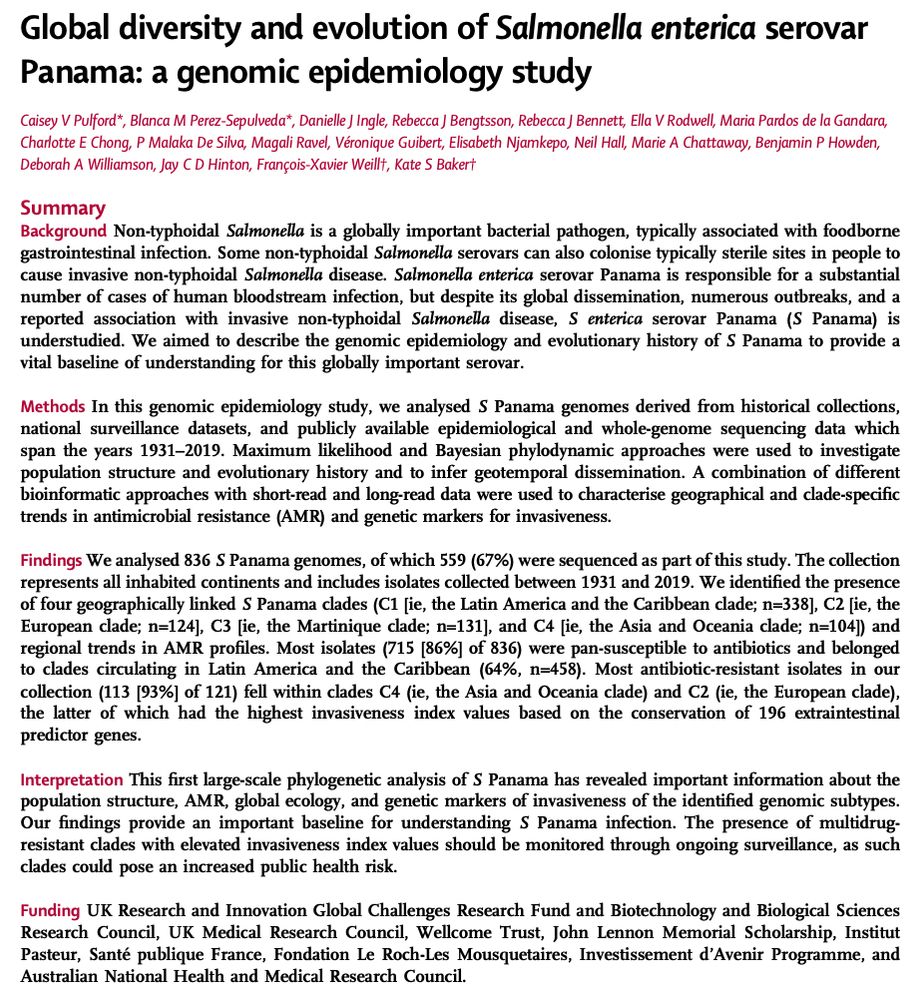
July 27, 2025 at 8:35 AM
There are half a million cases of invasive non-Typhoidal Salmonella (iNTS) every year and while you might know S. Typhimurim and Enteritidis, you may not have heard of S. Panama 💩 🩸 🧫 💊 Check out our latest in @lancetmicrobe.bsky.social doi.org/10.1016/j.la... and the 🧵 below to find out more 1/n


